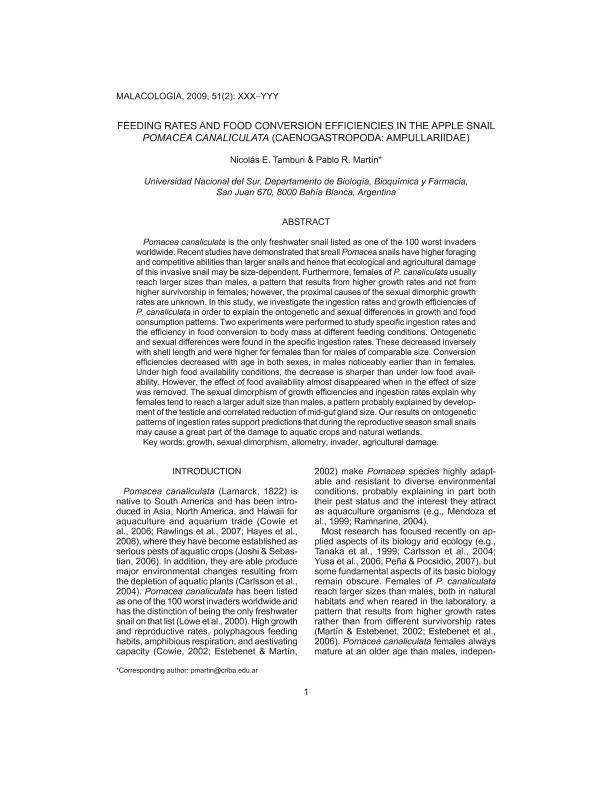Artículo
Feeding rates and food conversion efficiencies in the apple snail pomacea canaliculata (Caenogastropoda: Ampullariidae)
Fecha de publicación:
01/08/2009
Editorial:
Institute of Malacology
Revista:
Malacologia
ISSN:
0076-2997
Idioma:
Inglés
Tipo de recurso:
Artículo publicado
Clasificación temática:
Resumen
Pomacea canaliculata is the only freshwater snail listed as one of the 100 worst invaders worldwide. Recent studies have demonstrated that small Pomacea snails have higher foraging and competitive abilities than larger snails and hence that ecological and agricultural damage of this invasive snail may be size-dependent. Furthermore, females of P. canaliculata usually reach larger sizes than males, a pattern that results from higher growth rates and not from higher survivorship in females; however, the proximal causes of the sexual dimorphic growth rates are unknown. In this study, we investigate the ingestion rates and growth efficiencies of P. canaliculata in order to explain the ontogenetic and sexual differences in growth and food consumption patterns. Two experiments were performed to study specific ingestion rates and the efficiency in food conversion to body mass at different feeding conditions. Ontogenetic and sexual differences were found in the specific ingestion rates. These decreased inversely with shell length and were higher for females than for males of comparable size. Conversion efficiencies decreased with age in both sexes, in males noticeably earlier than in females. Under high food availability conditions, the decrease is sharper than under low food availability. However, the effect of food availability almost disappeared when in the effect of size was removed. The sexual dimorphism of growth efficiencies and ingestion rates explain why females tend to reach a larger adult size than males, a pattern probably explained by development of the testicle and correlated reduction of mid-gut gland size. Our results on ontogenetic patterns of ingestion rates support predictions that during the reproductive season small snails may cause a great part of the damage to aquatic crops and natural wetlands.
Palabras clave:
Agricultural Damage
,
Allometry
,
Growth
,
Invader
,
Sexual Dimorphism
Archivos asociados
Licencia
Identificadores
Colecciones
Articulos(CCT - BAHIA BLANCA)
Articulos de CTRO.CIENTIFICO TECNOL.CONICET - BAHIA BLANCA
Articulos de CTRO.CIENTIFICO TECNOL.CONICET - BAHIA BLANCA
Articulos(INBIOSUR)
Articulos de INSTITUTO DE CIENCIAS BIOLOGICAS Y BIOMEDICAS DEL SUR
Articulos de INSTITUTO DE CIENCIAS BIOLOGICAS Y BIOMEDICAS DEL SUR
Citación
Tamburi, Nicolas Eduardo; Martín, Pablo Rafael; Feeding rates and food conversion efficiencies in the apple snail pomacea canaliculata (Caenogastropoda: Ampullariidae); Institute of Malacology; Malacologia; 51; 2; 1-8-2009; 221-232
Compartir
Altmétricas




